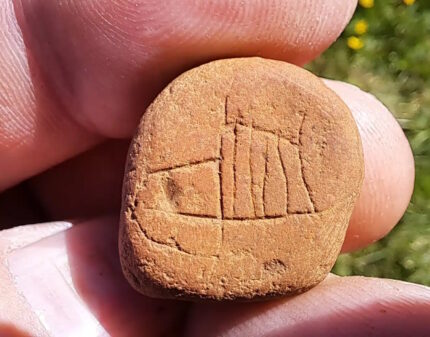 Archaeologists have found what is believed to be the oldest drawing in Iceland at the Stöð farm site in Stöðvarfjörður, east Iceland. A small rounded sandstone engraved with the image of a ship at sail was found in the wall of an early 9th century Viking longhouse. These types of ship carvings on bone, wood and stone are fairly common in Scandinavia, but this is the first one found in Iceland.
Archaeologists have found what is believed to be the oldest drawing in Iceland at the Stöð farm site in Stöðvarfjörður, east Iceland. A small rounded sandstone engraved with the image of a ship at sail was found in the wall of an early 9th century Viking longhouse. These types of ship carvings on bone, wood and stone are fairly common in Scandinavia, but this is the first one found in Iceland.
The Viking site on the northern shore of the fjord was discovered by accident in 2003. Exploratory digs began in 2015 followed by systematic excavations in 2018 and unearthed the remains of two Viking era longhouses, a newer one built on top of the remains of the older one. They were found under the layer of volcanic tephra that covered Iceland at some point between 869-873 A.D.. This was a momentous find, because it meant longhouses had been built and occupied before the official settlement year of 874 recorded in the written records (the Icelandic sagas the Landnámabók, or Book of Settlements).
Radiocarbon dating of the oldest longhouse dated it to around 800 A.D., indicating that the eastern fjords, at least, were occupied by Norse settlers 75 years before Ingólfur Arnarson left Norway and sailed to Iceland, founding Reykjavík as Iceland’s first permanent settlement. Archaeologists believe the Stöð site was a seasonal camp, used in the summer to fish, hunt, process whale blubber into oil and collect bog iron, rather than a permanent settlement.
Excavations have continued every summer. An enormous quantity of artifacts and remains have been found attesting to a large-scale operation of whaling and fish processing. That is confirmed by the sheer size of the longhouse — 103 feet long — which is twice the length of the earliest longhouses in Reykjavík. It is the richest longhouse ever excavated in Iceland, with 92 beads and 29 silver artifacts (including Roman and Arabic coins) unearthed.
A geophysical survey of the site performed this spring before the dig season began found evidence of more buildings and boats underground, the latter likely ship burials rather than wrecks. The boats and structures have yet to be excavated.